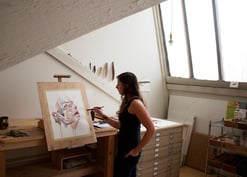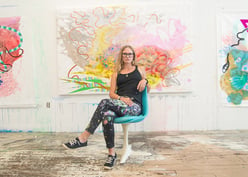Mini Mukherjee's artistic journey is one of strength, connection, and a conviction to create art that uplifts and inspires. After beginning her career in finance and tech, she found herself drawn to storytelling and creative expression, eventually pivoting to pursue a path as a sculptor and metalwork artist.
Working primarily in copper, brass, and steel, Mini employs techniques such as fire painting to infuse her pieces with warmth and emotion. Her work explores themes of joy, unity, and connection: values that inspired her "Joy Buddies" project, a series of sculptures that serve as tangible representations of resilience, community, and collective joy.
With a multifaceted perspective as an entrepreneur, collaborator, mother, and creative, Mini’s approach to art is thoughtful, authentic, and deeply human.
Tell us about your journey to becoming a professional artist. Was there a single defining moment or a moment of clarity when you knew this was your path?
My path into fine art was not traditional. I have a background in finance and spent the first decade of my career in financial services and tech. I did not go to art school (although I attended both Parsons School of Design and Otis College of Art and Design later in my art career) and had no connections in the art world, but I always felt drawn to storytelling.
In 2016, I signed up for a jewelry class and picked up a welding torch for the first time. I was immediately pulled in. That spark led me to search for mentors, build new skills, and slowly grow my voice as an artist. A year later, I rented my first art studio because my commission list had outgrown the apartment balcony where I was making my first sculptures.
Have other artists inspired your path? If so, can you share how they have influenced our work or career?
I often find inspiration in creatives who do not work in my medium. Artists working in animation, music, or even artistry-centered chefs remind me how much care goes into every detail when creating something meaningful. That level of attention to craft feels deeply artistic to me.
For the Joy Buddies project, I have had the privilege of collaborating with artists across different disciplines, including animation, music, and concept design. I find their work incredibly inspiring. Some of those artists include Charity Neal, Veronica Kosowski, Jerome Leroy, and Lorenzo Mercanti.
Among fine artists, I am drawn to those who are fiercely committed to their vision and craftsmanship. I admire CJ Hendry, Yayoi Kusama, Jeff Koons, and KAWS for their dedication to building meaningful worlds through their work.
What is most meaningful to you about being an artist? What drives you to continue creating and pursuing art?
What means the most to me is being able to make the world feel a little more beautiful and a little more connected. I’ve always admired how much courage it takes for artists to share their hearts through their work, especially when the world feels chaotic or uncertain. It is a vulnerable act, and doing it professionally requires a quiet strength that doesn’t always get the credit it deserves.
What keeps me going is the feeling that I still have something to say or to contribute to the world. When I reach a point where I’ve said all I want to, I’ll stop creating art in a professional capacity. I believe art can open hearts and bring people together, and I want to contribute to that, especially in the world my daughter is growing up in. She is only three, but she is a constant reminder of what truly matters. Creating for this next generation, and doing it with care, feels like both a responsibility and a gift.
I also care deeply about leadership. Whether I am leading my own practice or collaborating with others, I believe leadership is about taking risks and building the kind of team that brings a vision to life with integrity and purpose. I care as much about being a strong leader as I do about being a strong artist.
I believe art makes the world a better place, and I want to do my part, especially for my daughter’s generation. While I have my concerns about aspects of the world she’s growing up in, I believe that if you’re looking for beauty and joy, you’ll find it.
Tell us about your work. What themes or messages do you hope to convey through your art?
Joy is a recurring theme in my work. Not just happiness, but the kind of joy that is earned, sometimes fought for, and always shared. I am a curious person by nature, and I think that is why I am drawn to working across materials and formats. Over time, I have also noticed that I tend to gravitate toward circular forms. There is something about their softness and symbolism that I enjoy, and this repeatedly shows up in my work.
I primarily identify as a sculptor and metalwork artist. I work mostly in copper, brass, and steel, and I love materials that hold weight and presence. I also do a mix of private commissions and gallery work because I enjoy collaborating and contributing to something that feels connected to a larger purpose.
That spirit of collaboration is a big part of why I invited a team of artists, producers, and designers to help bring movement to the Joy Buddies in their new form. What began in 2017 as a sculpture series has grown into a multimedia art world, but the message remains the same. Joy. Unity. Connection.
Tell us about your process. Do you have any unique techniques or rituals that are integral to your work?
My process usually begins internally. I ask myself what I am working through and what values I feel drawn to express in that moment. I let those reflections guide the materials I choose and shape the direction of the work.
I often use a technique called fire painting, where I paint with a welding torch instead of traditional pigment. The heat brings out an incredible range of colors hidden within the metal. It has taken me years of practice to learn how to control the flame in a way that feels intentional. I love that the color is already there, just waiting to be revealed. It feels like a metaphor for the kind of beauty that comes from within.
When you are looking for inspiration, what resources do you turn to? Are there any particular experiences, places, or people that influence your creativity?
I always return to a few core sources. Transcendental Meditation helps me quiet excess noise and reconnect with what matters. My husband and daughter also ground me and inspire me in different ways. Being a parent has made me even more intentional with the kind of world I want to help shape through my work.
When I am feeling stuck or too in my head, I browse Pinterest. It helps me shift my perspective and return to a playful, curious mindset.
Do you consider yourself, and all artists, to be entrepreneurs? Why or why not?
I consider myself both an artist and an entrepreneur, partly because of my background. I have a degree in finance, and I spent the first ten years of my career in finance and tech before moving into fine art. That experience shaped how I approach my practice.
I won’t speak for all artists, but I believe having an entrepreneurial mindset can only help. It allows you to think long term, invest in your own growth, and build a practice that is both creatively fulfilling and sustainable.
Finding the right rhythm to be productive can be a challenge. What advice do you have for staying productive as an artist?
Think in focused sprints and plan your rest ahead of time as much as you can.
As a creative person, I am always a little bit “on,” which I have accepted because it’s very hard for me to ever fully “turn off.” I never really know when an idea will come to me, and I’m always open to inspiration. But if I am always working long days in the studio with no end in sight, it becomes difficult to care for the other important parts of my life.
Your relationships, health, and finances all need care and attention. When those areas are out of sync, it is challenging to stay in my creative flow. I have found that reserving periods of time for rest and reflection allows the work to grow sustainably and meaningfully.
What is your advice for combating creative blocks? Are there any specific strategies you use to reignite your creativity?
When I feel blocked, I try to step away from the pressure of producing and reconnect with something I’m grateful for. I write in my journal, pray, talk to a friend, or confide in my partner. These small rituals remind me that I am not alone and that creating is a gift. If I am really stuck, I try to remember not to take myself too seriously. That mindset shift helps me return to my practice with more lightness and perspective. I feel grateful that my work is in demand, and I try to honor that by not letting fear or doubt take the wheel.
Everyone is different, but these are the practices that keep me grounded and keep me going.
What sparked your interest in partnering with TurningArt?
TurningArt has been a thoughtful and patient partner as I have been building a new body of work for the Joy Buddies. I am especially grateful for my TA advisor, Sophia Palumbo (you are amazing!), for staying curious and engaged through this next chapter of my practice.
What I appreciate most is that everyone I have connected with at TA genuinely seems to care about the artists they represent and the clients they serve. That sense of integrity is not something I take for granted. I’m excited to continue to find new ways to partner with TA for this new “Joy Buddies” sculpture series set to release later this year.
As an artist, how do you measure your success? Can you recall a specific event or milestone in your career that made you feel successful?
I try to measure success against my past self, not against others. That helps me stay grounded and focused on growth. In the early days, success meant saying yes to every show, every sale, every opportunity. And that hustle helped build a strong foundation. But over time, my definition of success has shifted. Now, I think about success in a more holistic way. I want to feel proud of the life I am building - as an artist, a mother, and a partner. I want to invest in other artists and create something that extends beyond what I could do alone.
One moment that stands out is from my very first metalsmithing apprenticeship. My task was to make a perfect circle out of 18K gold. I remember how nervous I was because the material was so precious and unfamiliar. I burned dozens of pieces before I finally got it right. That moment made me proud because it had nothing to do with money or external validation. It was about pushing through fear and doing the work. That mindset has stayed with me ever since.

To see more featured TurningArtists, return to our blog. To get Mini Mukherjee's art in your space, set up a free consultation with an Art Advisor here!




_VSCO.jpg?width=332&height=177&name=TMoss_Continuum%20Sliver%20copy%20(1)_VSCO.jpg)

